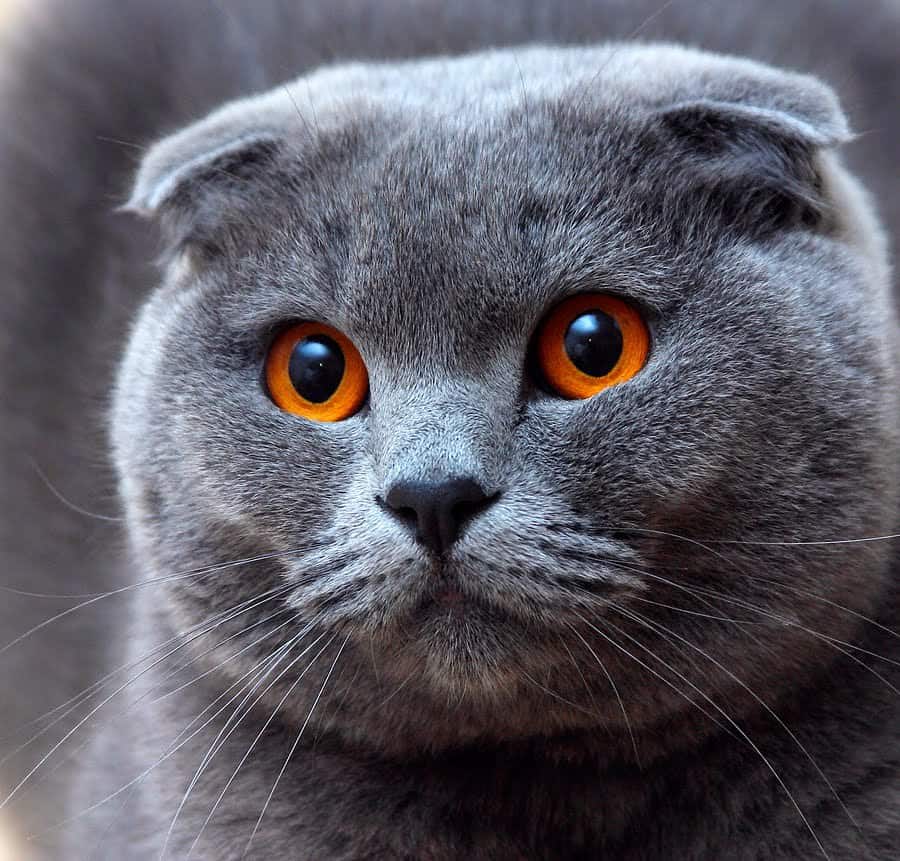Cat breed Scottish Fold. How many live. Ration. Education and training. Character, habits and features. Story. ⭐⭐⭐⭐⭐
Scottish Fold cat breed – description
Scottish fold cats appeared quite recently – the breed was officially registered at the end of the last century. These cats have excellent external data, thanks to which they immediately won the hearts of cat lovers. Scottish fold cats are distinguished by their characteristic floppy ears, plush-like fur coat and disarming open look.
History of the breed
If not for an accident, this breed would never have appeared – it happened in 1961. A Scottish farmer had a kitten with floppy ears, who was named after Susie. The mother of the kitten was a semi-wild cat Tabby, and no one knew what breed the father cat was. Susie began to give birth to kittens with the same strange floppy ears as her own.
Two years later, one of these kittens got a certain Mary, who named the pet Snooks. In the first litter of this cat there was a snow-white kitten, very similar to the Chinese fold. Mary made the decision to breed a new breed by crossing her cat's kittens with a British shorthair breed, and her pet Snooks with a luxurious British cat. So two lines of the Scottish Fold breed were designated.
Somewhat later, breeders isolated the gene responsible for the stable shape of drooping cat ears. During further work on the breed, it was revealed that if mother and father have hanging ears, their offspring are born with problems of the musculoskeletal system. For this reason, for breeding offspring, one of the parents must have erect ears. Until relatively recently, when compiling cat pedigrees, individuals with erect ears were recorded as British Shorthairs. Breeders indicate a separate type of offspring parents – Scottish Straight, or Scottish Shorthair. They differ from lop-eared prick ears. In modern catteries, breeding lop-eared cats are obtained by mating Folds with Straights. This is the only way to preserve all the signs of the breed and give the kittens a chance for good health.

The nature and habits of Scottish Fold cats
Scottish cats are excellent companions. They are distinguished by friendliness and sociability, high intelligence and trainability. The Scottish cat has an unusual habit of standing on its hind legs. So she unloads her spine and becomes like a meerkat. And the sounds that representatives of this breed make are more like a creak than a meow. Scottish, unlike many of their counterparts of other breeds, do not like heights at all, therefore they avoid climbing to a high level from the floor.They are very clean and go about their toilet business exclusively in the tray. Scottish folds are calm and affectionate, sociable, but unobtrusive.
Education and training of the Scottish fold
When deciding to get a Scottish kitten, you need to be prepared to take on a lot of responsibility. After all, the baby will have to not only feed and care for him, but also train him, so you need to familiarize yourself with the methods of raising tiny fluffy pets. First of all, it is important to accustom the kitten to the tray, as well as to the correct behavior. Lop-eared Scots are distinguished by good intelligence, therefore they are well brought up if they feel the master's care. It is also worth considering that they absolutely cannot stand loneliness, so it is necessary to devote enough personal time to them. If this is not done, the cat itself will begin to demand attention – jump on its owner's knees, lie down on the table, lay down on the keyboard and invent other ways. It is impossible to drive the pet away at such moments, because the cat will not understand discontent and may be offended. It is better to find some time to play with the kitten and let him throw out the energy accumulated during the day. It is especially important to play for about twenty minutes before going to bed – if this condition is met, the cat will get tired and fall asleep soundly all night.
If suddenly the kid decides to wake up the owner in the middle of the night and try to draw him into a fun game, in no case should you support this idea, let alone feed the pet. You must try not to pay attention to him and pretend that you continue to sleep, otherwise the nightly entertainment will be repeated from night to night.
When a Scottish fold tries to bite its owner, you need to clearly and confidently stop it. For example, a mother cat brings up her naughty offspring quite strictly – she bites them by the ear. If you immediately make it clear to the kitten that the owner should not be bitten like a toy, the Scottish will quickly understand this and a bad habit will not have time to form.
So that the cat does not spoil the furniture, using it to sharpen its claws, you need to accustom it to a scratching post specially designed for this. To this end, the kitten is brought to this object for several days, until he understands how this device can be used. After the kitten sharpened its claws for the first time on the scratching post, it is necessary to praise him. Also, to attract a pet, attractive smells are applied to the claw point device, which can be purchased at pet stores. And to scare away from furniture and carpets, on the contrary, repellent aromas, such as citrus fruits, can be applied – this is an extremely unpleasant option for cats. If for some reason you need to punish a pet, physical violence should not be used, because it is not only cruel, but also completely useless.The cat will simply be very scared and will experience a lot of stress from pain and anxiety. It is best to use a rattle for this purpose – you need to slightly touch the pet in the area of \u200b\u200bthe back and there will be enough noise for an effective educational process.
In a word, you need to start raising kittens the sooner the better. The main thing is to show patience, condescension and love.

What to feed a Scottish Fold
For feeding lop-eared Scottish, both ready-made and natural food is used. Both types can be used. If you choose prepared food, it is worth buying a product from trusted companies and following the manufacturer's recommendations when determining the portion size. Combining natural and ready-made food, it is strongly not recommended to mix two types of food. In the case of feeding only natural food, mixes are only welcome – the diet should include meat, as well as vegetables and porridge. An adult cat needs a complete protein diet and, in the case of natural food, the diet should include lean meat, sour-milk products and fish – certainly boneless. As sources of carbohydrates, the pet is offered bread, crackers and cereals. Fats in the natural diet of a cat should be obtained from vegetable oil and eggs. Make sure your cat has access to fresh water!
A daily feeding regimen is usually recommended two or three times a day. Portions should not be applied large, as the cat should not overeat and gain excess weight. Every day, a Scottish fold should receive 250 kcal, and a cat of the same breed will need 300 kcal.
Kitten diet
The kitten's diet needs to be selected even more carefully, since the little fluffy grows and develops, and not only the appearance, but also the future health of the pet depends on the quality of the food. Up to three weeks, the baby remains fed by the mother-cat, and after this period, you can begin to introduce complementary foods. For this purpose, kittens are given cow's or goat's milk, to which quite a bit of sugar is added.
From the eighth week, kittens are offered vegetable puree, boneless fish, porridge mixed with yolk, meat and cottage cheese. Starting from the age of six months, babies are transferred to an adult diet with three meals a day. The volume of milk is gradually reduced, and when feeding with natural food, special vitamins are added to the food.
How long do Scottish cats live
Lop-eared Scottish live for a long time, as they have strong immunity. On average, the life of these pets lasts seventeen years. With proper nutrition, careful care and positive heredity, representatives of this breed can easily live for more than twenty-five years – and even this is not the limit! There are known cases of cat longevity of more than thirty-three years – these are, of course, rare exceptions, but, nevertheless, they confirm the cat's ability to live up to this age.
You can try to predict the life expectancy of a cat – for this they carefully study its pedigree. If the ancestors of Scottish died at the age of seventeen to twenty years from natural death, most likely the cat will live a long and full-fledged life. It is known that animals with good immunity lead an active lifestyle, so if the kitten is mobile and inquisitive, then it has good health.
What depends on the life of the flowering scotch
The main factor that affects the life expectancy of cats of this breed is genetics. Thanks to selection, these animals boast of beauty and charm, but they are not safe from genetic diseases. Given this fact, it is recommended to study the cat’s passport when buying and finding out information about diseases and possible health problems with his parents.
Health and disease of the breed Scottish berth
Vyslowry Scots have inheritance ailments. Such diseases include diseases of the musculoskeletal system, heart pathology and renal polycystic. Bone problems are expressed in the form of lameness, immobility of the joints and a hardened tip of the tail. As soon as the first symptoms are found, you need to urgently contact the veterinary clinic – only in time the measures taken will insure the pet from major health problems.
Vaccinations for kittens and adult cats
Be sure to carry out annual vaccination with your cat. The very first vaccinations are made when the kitten is two to three months. If suddenly the owners do not have time to instill a pet during this period, it will be necessary to instill an animal after a change of milk teeth occurs. Two weeks later, a second vaccination is done.
Vaccinations protect against a number of diseases – calciosis, chlamyliosis, rhinotracheitis and panlacopenia. Ten days before vaccination, an anthelmintic procedure is done. It is very important not to forget about rabies vaccination. And if it is planned to let the animal go to self -lift, it is necessary to carry out regular processing from ticks and fleas.
Video about the breed Scottish berth
How much are Scottish Visloux
The price of kittens of the Vysloukh Scottish depends on several factors:
- Class: Pet, Brid, show.
- Health. Kittens with poor health are cheaper. If the breeder is unscrupulous, he may not inform the buyer about the problems of the kitten with health, so you need to ask a question on this topic yourself.
- Natural characteristics.
- Pedigree. Kittens from titled parents are more expensive, since victories at competitions are a guarantee of the purity of the breed and great potential.
- Breeder. Eminent breeders request a large sum for kittens because they contain animals in luxury conditions and have a reliable reputation.
Kittens of the show class-from twenty-five thousand rubles are most expensive.The most affordable are pet-class pets-their cost usually starts from ten thousand rubles.
Conclusions about the breed
Choosing a kitten, people are guided not only by reason, but also by their hearts. After all, we are talking about a real family member who will live with its owners the soul in the soul over the next 15-20 years! Scottish cats are wonderful friends who, with proper care, will live a long happy life and will delight the owners with a great mood, excellent health and a wonderful appearance.







